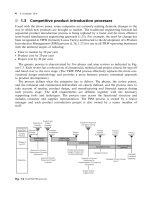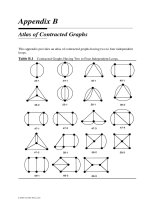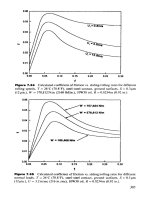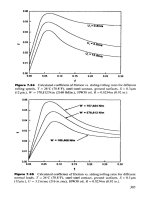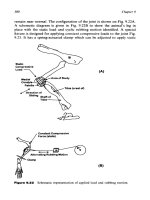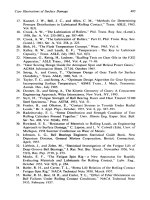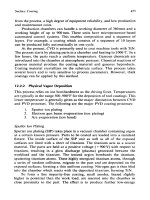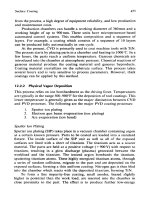product design development 2 pps
Bạn đang xem bản rút gọn của tài liệu. Xem và tải ngay bản đầy đủ của tài liệu tại đây (98.02 KB, 25 trang )
1
Product Design &
Development
Product Planning
2
Product Planning positioning
• The product planning phase precedes the
product development process
Planning
Planning
Concept
Development
Concept
Development
System-Level
Design
System-Level
Design
Detail
Design
Detail
Design
Testing and
Refinement
Testing and
Refinement
Production
Ramp-Up
Production
Ramp-Up
Four Phases of Product Development
3
Product Planning
• The Product Planning Process
• Identify Opportunities
• Evaluate and Prioritize Projects
• Allocate Resources and Plan Timing
• Complete Pre-Project Planning
• Summary
4
Xerox Lakes Project Example
Xerox Document Centre 265
5
The Product Planning Process
Questions
• What PD projects will be undertaken?
• What mix of new products, platforms, and
derivative products to pursue?
• How do the various projects relate to each
other as a portfolio?
• What will be the timing and sequence of
the project?
6
Mission Statement
• What market segments to consider?
• What new technologies to incorporate?
• What are the manufacturing and service
goals and constraints?
• What are the financial targets of the
project?
• What are the budget and time frame for
the project?
7
The Product Planning Process
8
The Product Planning Process
• The product plan identifies the portfolio of
products to be developed by the
organization and the timing of their
introduction to the market
9
The Product Plan
• The product plan identifies the portfolio of
projects to be pursued by the development
organization
• The plan may divide projects into four
categories: new platforms, derivatives of
existing platforms, product improvements,
and fundamentally new products (See
Exhibit 3-2)
10
Four Types of Product
Development Projects
• New product platforms
• Derivatives of existing product platforms
• Incremental improvements to existing
products
• Fundamentally new products
11
The Process
• Identify opprtunities
• Evaluate and prioritize projects
• Allocate resources and plan timing
• Complete pre-project planning
• Reflect on the results and the process
12
Identify Opportunities
Idea Sources for New Products
• Marketing and sales personnel
• Research and technolgy development
organizations
• Current product development teams
• Manufacturing and operation organizations
• Current or potential customers
• Third parties such as suppliers, inventors,
and business partners.
13
Evaluate and Prioritize Projects
• Opportunity funnel can collect 100s or
even 1000s of opportunities during a year.
• Select the most promising projects to
pursue.
• Basic perspectives to prioritize:
Competitive Strategy, market
segmentation, technological trajectories,
and product platforms
14
Competitive Strategy
• Technology leadership
• Cost leadership
• Customer focus
• İmitative
15
Market Segmentation
• Dividing a market into segments allows the
firm to consider the actions of competiters
and the strength of the existing products of
the firm wrt each well defined group of
customers.
16
Technological Trajectories
• In technology intensive businesses, a key
product decision is when to adopt a new
technology in a product line.
• Technoloy S-curves are conceptual tool to
help to think about such decisions.
17
Technology S-curves
Light-Lens
Technology
Digital
Technology
Time
Copier Performance
18
Product Platform Planning
• A platform development project creates
the architecture of a family of products.
• Derivative Products may be included in the
initial platform development effort or
derivative products may follow thereafter.
• One technique for coordinating technology
development with product planning is the
technology roadmap.
19
Platforms vs Derivatives
time
Platform B
Platform
Product
Development
Derivative
Product
Development
Legend
Project
Product
Release
Research and
Technology
Development
Platform A
20
Allocate Resources and Plan
Timing
• Resource allocation (Wheelwright and
Clark (1992)
21
Project Timing
• Timing of product introductions
• Technology readiness
• Market readiness
• Competition
22
Complete Pre-Project Planning
• Core team
• Product vision statement
• Mission statements
23
Mission statements
• Brief (one sentence) description of the
product
• Key business goals
• Target market(s) for the product
• Assumption and constraints that guide the
development effort (Manufacturing,
Service, Environment)
• Stakeholders
24
Reflect on the results and the
process
• Is the opportunity funnel collecting an
exciting and diverse set of product
opportunitie?
• Does the product plan support the
competitive strategy of the firm?
• Does the core team accept the challeges
of the resulting mission statement?
• How can the product planning process be
improved?
25
Summary
• Product planning involves a five-step process:1.
Identify opportunities, 2. Evaluate and prioritize
projects, 3. Allocate resources and plan timing,
4. Complete pre-project planning, 5. Reflect on
the results and the process.
• The opportunity funnel collects possibilities for
new product platforms
• A mission statement for each PD project
documents, the product vision, business goals,
target matkets, critical assumptions, and the
product’s stakeholders.
